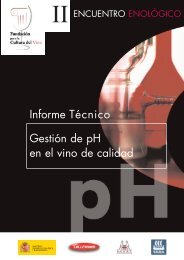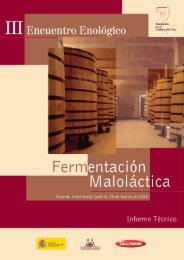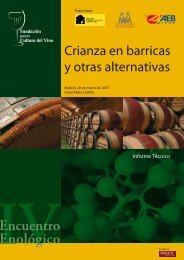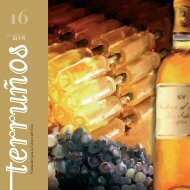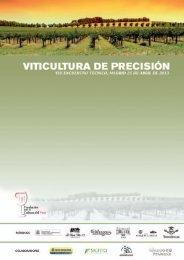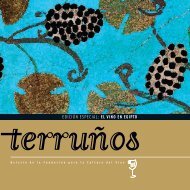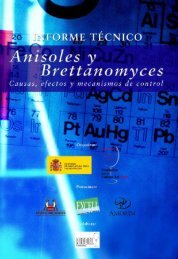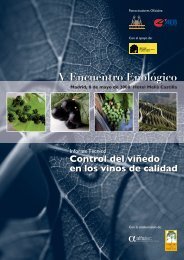Compuestos azufrados volátiles en vinos - Fundación para la ...
Compuestos azufrados volátiles en vinos - Fundación para la ...
Compuestos azufrados volátiles en vinos - Fundación para la ...
You also want an ePaper? Increase the reach of your titles
YUMPU automatically turns print PDFs into web optimized ePapers that Google loves.
y lowering higher alcohols production (Rapp andVersini 1991). However, based on the tr<strong>en</strong>d shown inFigure 3, this advice has to be tak<strong>en</strong> cautiously as itmight apply only to ferm<strong>en</strong>tations with initial YAN inthe range included in the desc<strong>en</strong>ding part of higheralcohols production pattern, i.e. YAN >200mg N/L.The production of fatty acids ethyl esters, as well as ofacetate esters, including ethyl acetate, is g<strong>en</strong>erally increasedwh<strong>en</strong> DAP is added to the juice prior to alcoholicferm<strong>en</strong>tation (Figure 3). This can have interestingimplications for wine fl avour as fatty acids ethyl estersand acetates are g<strong>en</strong>erally responsible for the fruitycharacter of wine (Guth and Sies 2002). However,ethyl acetate, one of the dominant yeast-derived vo<strong>la</strong>tilemetabolites, wh<strong>en</strong> pres<strong>en</strong>t at very high conc<strong>en</strong>trations,can give unwanted s<strong>en</strong>sory characteristics,oft<strong>en</strong> described with terms like nail <strong>la</strong>cquer/solv<strong>en</strong>tand vo<strong>la</strong>tile acidity. Branched chain esters are, from aquantitative point of view, the less abundant vo<strong>la</strong>tilesproduced during ferm<strong>en</strong>tation. Although their contributionto wine fl avour has still to be c<strong>la</strong>rifi ed, t<strong>en</strong>tativeevid<strong>en</strong>ce is avai<strong>la</strong>ble in the literature for thesecompounds to be important contributors to the redberry fruit character of some red wines (Diaz- Marotoet al. 2005). Their conc<strong>en</strong>tration appears to decreasewith increased DAP additions, however.The exist<strong>en</strong>ce of a variety of diff er<strong>en</strong>t responses forthe various groups of yeastderived vo<strong>la</strong>tile compoundsto DAP supplem<strong>en</strong>tation arises from the factthat each group of vo<strong>la</strong>tiles is derived from a diff er<strong>en</strong>tmetabolic pathway, each of which respond differ<strong>en</strong>tlyto DAP supplem<strong>en</strong>tation. However, from a practicalpoint of view, understanding the pot<strong>en</strong>tial of DAPsupplem<strong>en</strong>tation as a tool to modu<strong>la</strong>te wine s<strong>en</strong>sorycharacteristics cannot be based simply on compositionaldata. The various vo<strong>la</strong>tiles or groups of vo<strong>la</strong>tilesillustrated in Figure 3 occur in wine over an extremelybroad range of conc<strong>en</strong>trations. However, this fi guredoes not repres<strong>en</strong>t the actual quantitative re<strong>la</strong>tionshipbetwe<strong>en</strong> diff er<strong>en</strong>t chemical species. For example,higher alcohols, characterised by herbaceous, fusellikeodours, typically occur in conc<strong>en</strong>trations that canbe up to 400 times higher than ethyl fatty acid esters,Odour Activity Value120100806040200Isoamyl alcoholEthyl octanoateIsoamyl acetateEthyl 3-methylbutanoateEthyl acetate100 200 300 400 500YANFigure 4. Theoretical re<strong>la</strong>tionship betwe<strong>en</strong> initialYAN conc<strong>en</strong>tration and Odour Activity Values ofselected yeast-derived aroma compounds.Seminario Técnico<strong>Compuestos</strong> <strong>azufrados</strong> volátiles <strong>en</strong> <strong>vinos</strong>characterised by fruit-like odours. Nevertheless, re<strong>la</strong>tivelysmall variations in the conc<strong>en</strong>tration of ethyl fattyacid esters, such as those introduced by variations inYAN cont<strong>en</strong>t, are more likely to aff ect the aroma ofwine than if proportionally simi<strong>la</strong>r variations wouldoccur for higher alcohols. This is due to the fact thatsome of the possible s<strong>en</strong>sory modifi cations associatedwith changes in the conc<strong>en</strong>tration of specifi caroma compounds dep<strong>en</strong>d, among other factors, onthe ability of that aroma compound to g<strong>en</strong>erate anolfactory stimulus at a giv<strong>en</strong> conc<strong>en</strong>tration.This complex re<strong>la</strong>tionship is oft<strong>en</strong> simplifi ed bymeans of the concept of odour threshold, defi ned asthe minimum conc<strong>en</strong>tration at which a giv<strong>en</strong> compoundcan be detected by the s<strong>en</strong>se of smell (Guth1997). This is referred to as the odour activity value(OAV). Some of the ferm<strong>en</strong>tation-derived vo<strong>la</strong>tilecompounds, such as esters, that are g<strong>en</strong>erally associatedwith the fruity character of wine, are extremelypowerful odourants (i.e. have a very low odour threshold)and can, therefore, impart specifi c s<strong>en</strong>sory attributesev<strong>en</strong> wh<strong>en</strong> pres<strong>en</strong>t in low conc<strong>en</strong>trations. Onthe contrary, compounds like higher alcohols possessa much higher odour threshold and, therefore, arelikely to g<strong>en</strong>erate variations in the aroma profi le ofa wine only wh<strong>en</strong> their conc<strong>en</strong>tration varies to a very<strong>la</strong>rge ext<strong>en</strong>t. In Figure 4, a theoretical re<strong>la</strong>tionship betwe<strong>en</strong>the OAV of selected vo<strong>la</strong>tile compounds, belongingto the chemical c<strong>la</strong>sses of Figure 3, and DAP supplem<strong>en</strong>tationis illustrated. It appears clear th<strong>en</strong> thatthe range of variations pot<strong>en</strong>tially introduced by DAPin the conc<strong>en</strong>tration of acetates and fatty acid ethylesters (isoamyl acetate and ethyl octanoate are usedas refer<strong>en</strong>ce compounds for these two c<strong>la</strong>sses) canhave a dramatic impact on the vo<strong>la</strong>tile character ofwine, whereas variations in compounds such as higheralcohols (isoamyl alcohol), although quantitativelyextremely <strong>la</strong>rge, are likely to have a limited impact.Although it has to be stressed that OAVs only give aprojection of the pot<strong>en</strong>tial of a giv<strong>en</strong> compound tocontribute to the overall aroma of a wine, the tr<strong>en</strong>dsshown in Figure 4 provide a good indication of whichone of the compositional changes associated withDAP supplem<strong>en</strong>tation is likely to have a greater impacton wine aroma.IMPLICATIONS OF NITROGEN FOR WINEFERMENTATIONS3.1 Implications of nitrog<strong>en</strong> for white wineferm<strong>en</strong>tationsInterestingly, the results obtained in various winemakingtrials conducted at the AWRI with sub-optimalYAN juices have indicated that, under typical winemakingconditions, DAP supplem<strong>en</strong>tation is an extremelypowerful tool for modu<strong>la</strong>ting the production of esterswhich, based on the previous discussion, are probablyTextos asociados67



